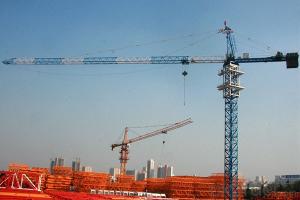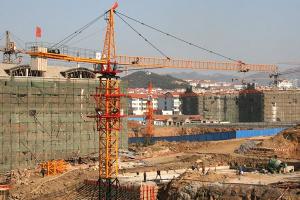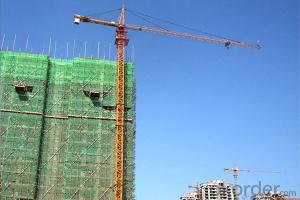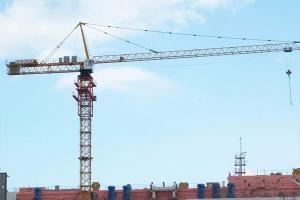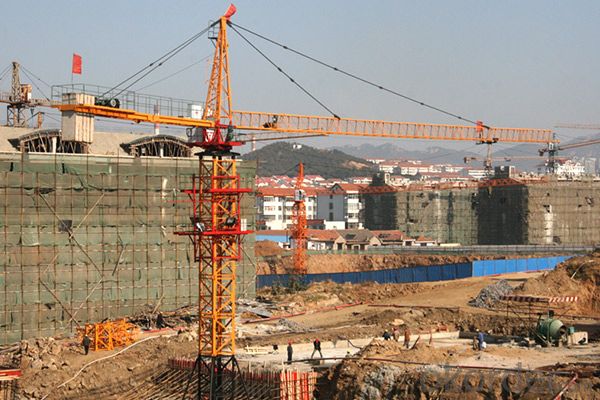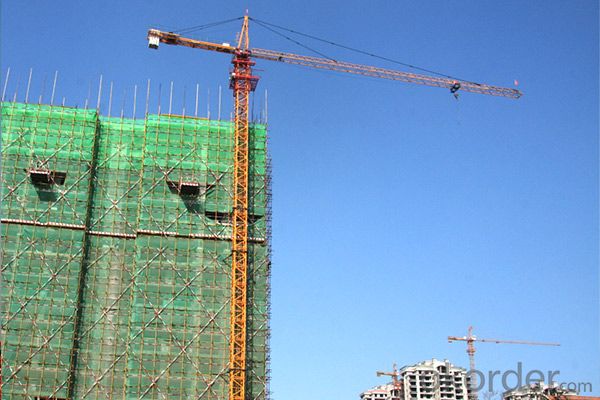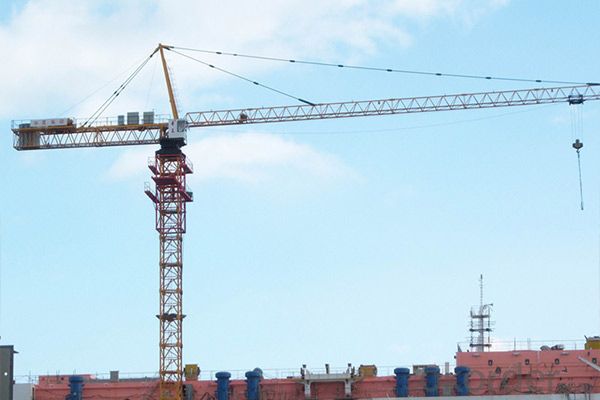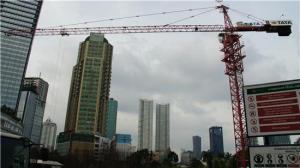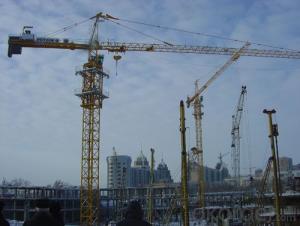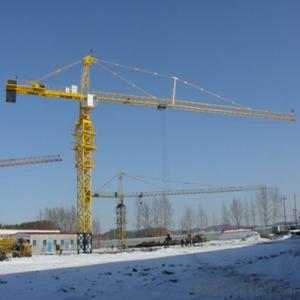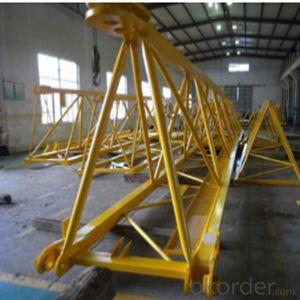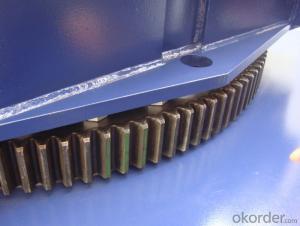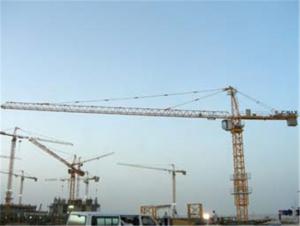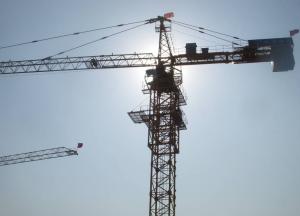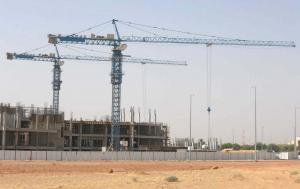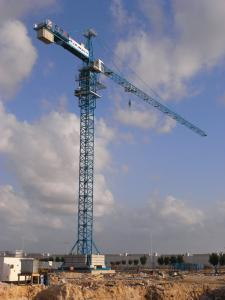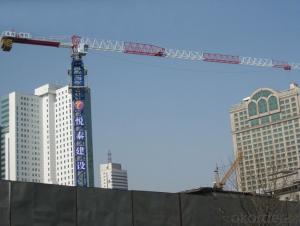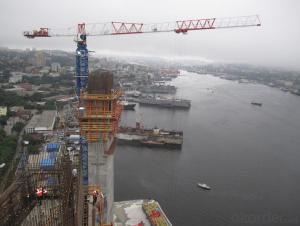TOWER CRANE TC4610AC
- Loading Port:
- Tianjin
- Payment Terms:
- TT OR LC
- Min Order Qty:
- 1 set
- Supply Capability:
- 12 set/month
OKorder Service Pledge
OKorder Financial Service
You Might Also Like
Technology is the drive for business development and production equipment the assurance of product quality. In the large-scale concentrated production, the stability and uniformity of product quality plays an essential role. The company constantly improves processing equipment. The automatic assembly line ensured quality stability and maximally reduced adverse effect of personal factor to the product quality. As a result, the one-time qualification rate of the products is improved and the company is able to win continuous trust from customers。
1. The lifting boom and balance boom adopt cantilever boom structure, which reduces the hoisting modular and makes it more safe, convenient and flexible to install and uninstall, and reduces the requirements for hoisting equipment and the site.
2. Multiple special mounting brackets are available, which saves the installation time and ensures safe and quality installation.
3. The lifting boom adopts cantilever boom structure and variable cross-section materials, featuring more reasonable structural stress and long service life; and it is easier to make different combination of boom length.
4. It adopts standard sections (for models of over 12t) of piece assembly structure, split structure stock, and assembled platform, which meet the transport requirements for standard container.
5. The extra-long boom is designed with a rope-supporting trolley, and the speed of which is 1/2 of that of the luffing trolley, which can achieve the most optimum rope-supporting effect. The structure has applied for national patent.
6. The lifting mechanism adopts speed regulation by frequency control or by eddy current brake series resistance, featuring good lifting performance; The slewing system adopts frequency control by torque electric motor or by coil winding type electric motor with hydraulic coupler, featuring smooth operation and small slewing impact.
7. All kinds of safety devices are reliable and easy to adjust; both the safety monitoring control system and traditional safety system are available, the double system ensures safety operation of the tower crane; the hydraulic system adopts low/medium pressure design, featuring higher safety and reliability.
The construction hoist product produced has achieved internationally advanced level in terms of industrial design, control and the drive performance, as well as the operation safety and comfortableness. And is also making efforts to keep improving the product, as what the construction hoist lifts is not only people and material, but also a kind of social responsibility and service concept…
The new generation SC series of construction hoists adopt modular structure, ergonomic design and advanced manufacturing technology, thus the adaptability and reliability of the product is greatly improved, e.g. the max. lifting height can reach 300 meters. The product adopts multiple patented technologies, reaches advanced level in China, and the market share in domestic market is increasing year by year. The product has also been exported to overseas countries like Russia, Turkmenstan, Vietnam, etc. winning the confidence of customers of both home and abroad
1. The cage drive system is equipped with buffering device, so the cage moves more stable.
2. The ergonomically designed cage interior improves comfortableness.
3. The unique structural design has applied for patent.
4. The typical technologies ensure the malposition difference of the guide rail.
5. The excellent parts in the industry ensures reliable quality of the machine.
6. Precise assembly and accurate drive.
7. Professional solutions for special projects.
8. The complete safety devices ensures reliable control system.
Model | Max.lifting capacity & work range | Max.work range & lifting capacity | Max.independent lifting height(m) | |||
Torque | Lifting capacity at max.boom length | Lifting capacity(t) | Work range(m) | Work range(m) | Lifting capacity(t) | |
QTZ31.5 | TC3508 | 3 | 11.59 | 35 | 0.8 | 29 |
TC3807 | 3 | 11.15 | 38 | 0.7 | 29 | |
QTZ40 | TC4208 | 4 | 11.6 | 42 | 0.8 | 29 |
TC4708 | 4 | 13.4 | 47 | 0.8 | 29 | |
QTZ50 | TC4610 | 5 | 11.9 | 46 | 1 | 36 |
TC5010 | 5 | 13.1 | 50 | 1 | 36 | |
QTZ63 | TC5013 | 6 | 13.72 | 50 | 1.3 | 40 |
TC5013A | 6 | 13.72 | 50 | 1.3 | 40 | |
TC5510 | 6 | 13.17 | 55 | 1 | 40 | |
TC5510A | 6 | 13.17 | 55 | 1 | 40 | |
QTZ80 | TC5512 | 8 | 12.68 | 55 | 1.2 | 45 |
QTZ100 | TC6013 | 8 | 14.45 | 60 | 1.3 | 45 |
QTZ125 | TC6014A | 10 | 12.4 | 60 | 1.4 | 50 |
QTZ160 | TC6020 | 10 | 15.2 | 60 | 2 | 52.6 |
QTZ250 | TC7030 | 12 | 20.4 | 70 | 3 | 45 |
- Q: I understand the Crane stances and know there are more than one. I am referring to the single leg crane stance. I also know that stances are only used briefly. But I am curious, does this stance have any bunkai applications? Or is it only useful against dodging a kick or preparing to kick?
- In your search for a literal identification of the crane stance, or any physical move for that matter concerning any martial arts is problematic. Although fighting techniques can be identified clearly and others obscure. Instead, try looking at it for its most elementary purpose. That is to say not what can I do with it , but rather what it actually is. By definition any stance is a method of travel to get form place to place, and to enhance your defense and offensive techniques. But not limited to only that. The possibilities then become whatever you discover! As a mater of fact, during any give day the amount of times you use a single leg stance would surprise you. I hope this helps.
- Q: National standards for tower cranes
- Tower crane GB/T5031 - 2008 has been implemented since February 1, 2009. In accordance with the new standards promulgated, chief editor -- China Academy of Building Research Institute of building mechanization of Langfang, Beijing and Hebei respectively in Hangzhou, Nanning held the new standards xuanguan. Luo Wenlong, director of the standard editor and vice president of Li Shoulin, explained the new standards comprehensively. The new standards are quite different from the previous standards, adding a lot of security related content, mainly embodied in the following 3 aspects: 1) the principle of different. Previously considered issues mainly consider the domestic tower crane industry technology status, appropriately reflect the advanced nature, and now is the requirements and international benchmarking, consider safety. 2) different forms of organization. The standard used in scientific research institutes, universities, factory assistant; the preparation unit including Research Institute, and the host plant, supporting enterprises, universities, inspection unit, there are relatively large units on behalf of (rental business), etc..
- Q: A man said to the universe:“Sir, I exist!“However,” replied the universe,“The fact has not created in meA sense of obligation.”
- It's recognizes no one.... I'm just guessing.
- Q: IN HEAVY LIFTING WORKS, Which type of crane is better ? Certain area I See Cranes with JIbs are being used and for same type of lifting jobs i See TELESCOPIC CRANES are used. Ofcourse both are Mobile cranes. I see JIB cranes are assembled at site ...
- Not really Better - they each serve their purpose. Telescopic cranes are easier to move around the job, but don't lift as much and can't move with a load. They usually have rubber tires and must set up on their jacks prior to lifting. Crawler cranes, as we call them, can pick up a load and move with it since it is on tracks. They are larger and wider, slower and less versatile.
- Q: determine the maximum load the crane can support in kg if the bending moment on the beam is not to exceed 5000 Nm and the shear force is not to exceed 3KN when the crane is positioned at mid span
- figure shear first Let F be the max. crane load. for a simply supported symmetric load, the reactions at each end support will be half the total load. The reaction loads will also equal the shear load. 3000 N = (F + 150(9.8))/2 F = 4530 N The maximum bending moment will be the shear force times the moment arm of half the joist length 5000 Nm = [(F + 150(9.8))/2] N (2.0 m) 5000 = F + 150(9.8) F = 3530 N The bending moment max load is 1000 N less than the Shear max load so bending is the limiting factor The maximum load allowed is F = 3530 N 3530 / 9.8 = 360 kg As a form of exchange, please remember to vote a Best Answer from your results.
- Q: Where i live i get a damn lot of these come in my house.... I usually just leave them unless there are too many. This was before i was told that they are in fact one of the most venomous creatures on the planet. I laughed, but then was told the same by a friend.Im now Little worried about them coming near me. I understand they have no ability to sting but still... Should i worry about them flying around my house? I was thinking if i were to squash one, doesn't that mean the venom is now on my hand?!Are they really the most venomous creatures on earth? Or am i making a mountain out of a molehill? Thanks
- It is a complete myth. Confusion can arise because there are three different animals commonly called daddy-long-legs - spiders of the family Pholcidae, harvestmen (which are arachnids, but not spiders), and crane flies (which are insects). The myth about 'daddy-long-legs' being extremely venomous was originally applied to pholcid spiders, perhaps because they often kill highly venomous species like the black widow. Because the name is shared by harvestmen and crane flies, the myth is now often applied to them too. It is false in all cases. Whilst pholcid spiders are venomous, their venom is far too mild to be dangerous to humans - it causes nothing more than a slight tingling sensation. Harvestmen and crane flies have no fangs or venom whatsoever, and are completely harmless.
- Q: Are the creators of the Karate Kid movies apologetic about the white crane defensive stance?
- Why should they be? That stance is from an art that is practiced by a small number of practitioners in Okinawa known as Hakutsuru, which means White Crane. It was hollywood-ized... so what? The original movie was written by a practitioner of Goju Ryu, who trained in NYC under an instructor from the Bronx named Kao Loong Ong. He knew there was a link between White Crane and the development of Okinawan Karate. Robert Kamen trained with Kayo, as he is known, who is Chinese and is well known in NYC's China Town. If they should apologize, hollywood must apologize for their misrepresentation of SO many things - insults to practically all the cultures of the world.
- Q: Yeah, I think I know what cranes are used for. But in the context of building an apartment and so on, what is the role derricks there. And why is called cranes and derricks - What is the correlation between them.
- Cranes are used for lifting heavy equipment. Derricks are used to drill for oil. They are two different things.
- Q: My understanding is that under Crane doctrine the tax basis of the property to begin with is Equity Invested + Financing (recourse or nonrecourse doesn't matter). i.e. 20K down + 80K purchase money mortgage = 100K. What if the property is appraised for only 80K right before purchase but purchaser paid 100K? Is the tax basis 80K or 100K.In other words, is the tax basis the actual assessed value of the property or is the tax basis the total investment?Thanks,Ben
- Your understanding of Crane is correct. For purposes of calculating the gain on sale, the basis would be $100k. What Crane really said was that the net proceeds would have to include any assumed debt, in addition to any cash received -- basically that you had to include the debt on both ends of the transaction if my reading is correct. (That jives with the example in Commissioner v Tufts et al, 81-1356 so I think we're correct on that.) Where basis gets interesting is when you are calculating depreciation. At least when you convert a residential property to business use -- i.e. a rental -- you use the LESSER of the cost basis (Crane) or the FMV on the date that the property is placed in business(rental) service. In your example, the depreciable basis would be $80k since that was the lower. For calculating the gain on sale, the cost basis would still be $100k (adjusted down for any depreciation allowed or allowable while in business use of course).
- Q: Who was the guy called the Headless Horseman in the story of Ichabod Crane?
- A Lib
Send your message to us
TOWER CRANE TC4610AC
- Loading Port:
- Tianjin
- Payment Terms:
- TT OR LC
- Min Order Qty:
- 1 set
- Supply Capability:
- 12 set/month
OKorder Service Pledge
OKorder Financial Service
Similar products
Hot products
Hot Searches
Related keywords
